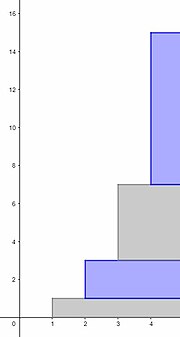1 2 3 4 5item# 289624 8 Reviews Add Review Free Shipping (Orders Over $5900) Mon Paris Ysl

The outset 4 partial sums of i + 2 + 4 + 8 + ⋯.
In mathematics, 1 + ii + 4 + 8 + ⋯ is the infinite series whose terms are the successive powers of two. Equally a geometric serial, it is characterized past its get-go term, i, and its common ratio, 2. Every bit a series of real numbers it diverges to infinity, so in the usual sense it has no sum. In a much broader sense, the series is associated with another value besides ∞, namely −ane, which is the limit of the serial using the ii-adic metric.
Summation [edit]
The partial sums of are since these diverge to infinity, and so does the series.
Therefore, whatever totally regular summation method gives a sum of infinity, including the Cesàro sum and Abel sum.[one] On the other manus, there is at least i generally useful method that sums to the finite value of −1. The associated ability serial
has a radius of convergence around 0 of merely so it does not converge at However, the so-divers function has a unique analytic continuation to the circuitous aeroplane with the bespeak deleted, and it is given past the same dominion Since the original series is said to exist summable (E) to −1, and −i is the (E) sum of the series. (The note is due to G. H. Hardy in reference to Leonhard Euler's arroyo to divergent series).[ii]
An well-nigh identical approach (the one taken by Euler himself) is to consider the power series whose coefficients are all 1, that is,
and plugging in These two series are related past the exchange
The fact that (E) summation assigns a finite value to shows that the general method is non totally regular. On the other manus, it possesses some other desirable qualities for a summation method, including stability and linearity. These latter two axioms actually force the sum to be −1, since they make the following manipulation valid:
In a useful sense, is a root of the equation (For example, is one of the two fixed points of the Möbius transformation on the Riemann sphere). If some summation method is known to return an ordinary number for ; that is, not then it is hands determined. In this case may be subtracted from both sides of the equation, yielding and then [3]
The above manipulation might be called on to produce −one outside the context of a sufficiently powerful summation procedure. For the most well-known and straightforward sum concepts, including the fundamental convergent one, it is absurd that a series of positive terms could take a negative value. A similar miracle occurs with the divergent geometric series (Grandi's series), where a series of integers appears to have the non-integer sum These examples illustrate the potential danger in applying like arguments to the series unsaid by such recurring decimals as and most notably . The arguments are ultimately justified for these convergent series, implying that and but the underlying proofs demand conscientious thinking about the interpretation of endless sums.[4]
It is also possible to view this series equally convergent in a number system different from the existent numbers, namely, the 2-adic numbers. Equally a series of ii-adic numbers this series converges to the aforementioned sum, −1, every bit was derived above by analytic continuation.[v]
See also [edit]
- 1 − 1 + two − half-dozen + 24 − 120 + · · ·
- Grandi's series
- 1 + 1 + 1 + i + · · ·
- ane − two + 3 − 4 + · · ·
- one + ii + 3 + 4 + · · ·
- 1 − ii + 4 − 8 + ⋯
- Ii's complement, a information convention for representing negative numbers where −1 is represented as if it were 1 + two + 4 + ⋯ + 2 n−i .
Notes [edit]
References [edit]
- Euler, Leonhard (1760). "De seriebus divergentibus". Novi Commentarii academiae scientiarum Petropolitanae. five: 205–237.
- Gardiner, A. (2002) [1982]. Understanding infinity: the mathematics of space processes (Dover ed.). Dover. ISBN0-486-42538-10.
- Hardy, G. H. (1949). Divergent Series. Clarendon Press. LCC QA295 .H29 1967.
Farther reading [edit]
- Barbeau, E. J.; Leah, P. J. (May 1976). "Euler's 1760 paper on divergent series". Historia Mathematica. 3 (2): 141–160. doi:x.1016/0315-0860(76)90030-6.
- Ferraro, Giovanni (2002). "Convergence and Formal Manipulation of Series from the Origins of Calculus to Well-nigh 1730". Annals of Science. 59: 179–199. doi:10.1080/00033790010028179.
- Kline, Morris (Nov 1983). "Euler and Space Serial". Mathematics Magazine. 56 (v): 307–314. doi:10.2307/2690371. JSTOR 2690371.
- Sandifer, Ed (June 2006). "Divergent series" (PDF). How Euler Did Information technology. MAA Online.
- Sierpińska, Anna (Nov 1987). "Humanities students and epistemological obstacles related to limits". Educational Studies in Mathematics. xviii (iv): 371–396. doi:10.1007/BF00240986. JSTOR 3482354.
morelandsoutimseling.blogspot.com
Source: https://en.wikipedia.org/wiki/1_%2B_2_%2B_4_%2B_8_%2B_%E2%8B%AF




























0 Response to "1 2 3 4 5item# 289624 8 Reviews Add Review Free Shipping (Orders Over $5900) Mon Paris Ysl"
Post a Comment